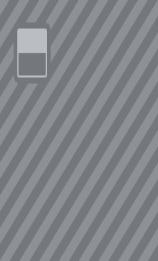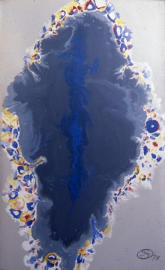



All texts copyright Richard Shillitoe
sephiroth
1978-79
Ten works. Enamel on paper.
Each 10 x 6¼in. (26 x 16.4cm.)
Each monogrammed and dated:
/1. and /2. 1978.
/3. to /10. 1979.
Bound in a hard-backed book. Chokmah
Provenance
NT.
Literature
Shillitoe & Morrisson, 2014, illustrate “Binah” as fig. 13.
These are Colquhoun’s only works in enamel on paper where the image does not completely cover the
surface of the paper. Generally, in the present series, the image is an oval form, centred on the sheet,
although the paint does sometimes extend to an edge. They are also the only works (with the
exception of some Taro cards) which have been painted in successive stages, in order to achieve the
complexities of the pre-determined colour schemes.
Although the paintings are untitled, the subject matter is unmistakable. Each painting shows one of
the sephirah of the Tree of Life, coloured to represent its appearance in each of the Four Worlds of
existence, passing from light to matter. The worlds are the Archetypal World (Atziluth), the Creative
World (Briah), the Formative World (Yetzirah) and the Material World (Assiah). Each sephiroth in each
world has its characteristic occult colour attributions. These and an explanation of the Four Worlds
may be found in Fortune (2000).
An example will demonstrate Colquhoun’s method. Chokmah, the second sephirah has the colour
attributions:
Atziluth – pure soft blue
Briah - grey
Yetzirah – pearl-grey
Assiah – white flecked with red, blue and yellow.
The colour of Chokmah in Atziluth forms the centre of the painting. The others follow in sequence,
until the colours of Assiah encircle the whole image.
By binding the paintings in one volume, Colquhoun has transformed the Tree of Life into The Book of
Life.
Allied to the paintings is a suite of ten poems, The Decad of Intelligence. The title refers to the ten
Intelligences or spheres of the qabalistic Tree of Life. Each poem lists some of the qualities, symbols
and ideas traditionally associated with the sphere in question. These include the ruling planet,
mundane chakra, words of power and the magical image.
The association between the paintings and the poems is indisputable, although the link is nowhere
made explicit by Colquhoun: the typescript of the poems makes no reference to the paintings and the
notebook containing the paintings makes no reference to the poems.
Note
Fortune, D. 2000. “The Mystical Qabalah”. San Francisco: Weiser Books. First published 1935.



















